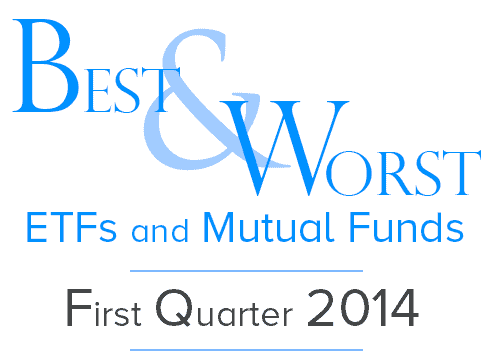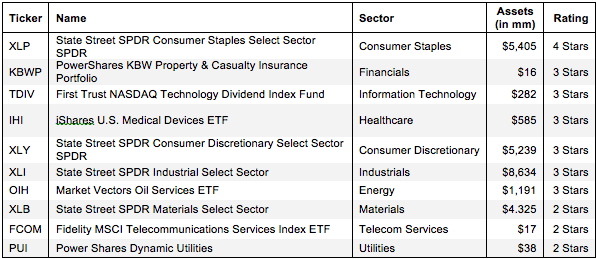Finding the best ETFs is an increasingly difficult task in a world with so many to choose from.
You Cannot Trust ETF Labels
There are at least 45 different Financials ETFs and at least 182 ETFs across all sectors. Do investors need that many choices? How different can the ETFs be?
Those 45 Financials ETFs are very different. With anywhere from 21 to 550 holdings, many of these Financials ETFs have drastically different portfolios, creating drastically different investment implications.
The same is true for the ETFs in any other sector, as each offers a very different mix of good and bad stocks. Some sectors have lots of good stocks and offer quality funds. The opposite is true for some sectors, while others lie in between these extremes with a fair mix of good and bad stocks. For example, the Financials sector, per my 1Q Sector Rankings Report, ranks ninth out of 10 sectors when it comes to providing investors with quality ETFs. Consumer Staples ranks first. Utilities ranks last. Details on the Best & Worst ETFs in each sector are here.
The bottom line is: ETF labels do not tell you the kind of stocks you are getting in any given ETF.
Paralysis By Analysis
I firmly believe ETFs for a given sector should not all be that different. I think the large number of Financials (or any other) sector ETFs hurts investors more than it helps because too many options can be paralyzing. It is simply not possible for the majority of investors to properly assess the quality of so many ETFs. Analyzing ETFs, done with the proper diligence, is far more difficult than analyzing stocks because it means analyzing all the stocks within each ETF. As stated above, that can be as many as 550 stocks, and sometimes even more, for one ETF.
Any investor worth his salt recognizes that analyzing the holdings of an ETF is critical to finding the best ETF.
Figure 1: Best Sector ETFs
The Danger Within
Why do investors need to know the holdings of ETFs before they buy? They need to know to be sure they do not buy a fund that might blow up. Buying a fund without analyzing its holdings is like buying a stock without analyzing its business and finances. As Barron’s says, investors should know the Danger Within. No matter how cheap, if it holds bad stocks, the ETF’s performance will be bad.
PERFORMANCE OF FUND’S HOLDINGS = PERFORMANCE OF FUND
Finding the Sector ETFs with the Best Holdings
Figure 1 shows my top rated ETF for each sector. Importantly, my ratings on ETFs are based primarily on my stock ratings of their holdings. My firm covers over 3000 stocks and is known for the due diligence we do for each stock we cover. Accordingly, our coverage of ETFs leverages the diligence we do on each stock by rating ETFs based on the aggregated ratings of the stocks each ETF holds.
State Street SPDR Consumer Staples Select Sector SPDR (XLP) is the top-rated Consumer Staples ETF and the overall top-rated fund of the 182 sector ETFs that I cover. Only the Consumer Staples sector contains any Attractive (i.e. 4-star) rated ETFs, while the best every other sector can offer is a Neutral or 3-star ETF.
Sometimes, you get what you pay for.
It is troubling to see one of the best sector ETFs, First Trust NASDAQ Technology Dividend Index Fund (TDIV) have just $282 million in assets despite its 3-star rating. On the other hand, Dangerous-rated iShares North American Tech-Software ETF (IGV) has $1,165 million in assets. IGV has lower total annual costs than TDIV (0.53% and 0.55% respectively), but low costs cannot drive positive performance. Quality holdings are the ultimate driver of performance.
I cannot help but wonder if investors would leave IGV if they knew that it has such a poor portfolio of stocks. It is cheaper than TDIV, but, as previously stated, low fees cannot growth wealth; only good stocks can.
Sometimes, you DON’T get what you pay for.
The smallest ETF in Figure 1 is PowerShares KBW Property & Casualty Insurance Portfolio (KBWP) with just $16 million in assets. Sadly, other Financials ETFs with more assets and inferior portfolios charge more than KBWP. In other words, Financials ETF investors are paying extra fees for no reason.
iShares U.S. Broker-Dealers ETF (IAI) is one of the worst ETFs in the Financials sector. It gets my Dangerous rating based off the fact that only 13% of its assets are allocated to Attractive-or-better rated stocks while 45% is allocated to Dangerous-or-worse stocks. IAI also has total annual costs of 0.53%, higher than KBWP’s 0.39%. One would think that IAI would have fewer assets than KBWP, but instead it has over $263 million. Investors are paying extra fees for poor holdings.
The worst ETF in Figure 1 is PowerShares Dynamic Utilities (PUI), which gets a Dangerous (2-star) rating. One would think ETF providers could do better for this sector.
I recommend investors only buy ETFs with more than $100 million in assets. You can find more liquid alternatives for the other funds on my free ETF screener.
Covering All The Bases, Including Costs
My ETF rating also takes into account the total annual costs, which represents the all-in cost of being in the ETF. This analysis is complex for ETFs, as one has to consider not only expense ratios, but also front-end load and transaction fees. A high front-end load not only costs investors at the beginning, it also reduces the growth investors can experience later on. While costs play a smaller role than holdings, my ratings penalize those funds with abnormally high costs.
Top Stocks Make Up Top ETFs
3M Company (MMM) is one of favorite holdings in State Street SPDR Industrial Select Sector SPDR (XLI) and earns my Attractive rating. MMM has grown after-tax profits (NOPAT) by 10% compounded annually for the past decade, which means last year’s NOPAT 260% greater than it was ten years ago. They currently earn a top quintile return on invested capital (ROIC) of 18%, double the average among the other industrial conglomerates I cover.
Despite its strong history of profit growth, the market still underestimates the value of MMM. At ~$127/share, MMM has a price to economic book value (PEBV) ratio of 1.5. This ratio implies the market expects MMM to never grow NOPAT by more than 50% from its current level. With the company’s track record of consistent profit growth, this expectation seems rather pessimistic. Long-term investors should look at MMM as a company with low risk and great upside.
Kyle Guske II contributed to this post.
Disclosure: David Trainer and Kyle Guske II receive no compensation to write about any specific stock, sector, or theme.

